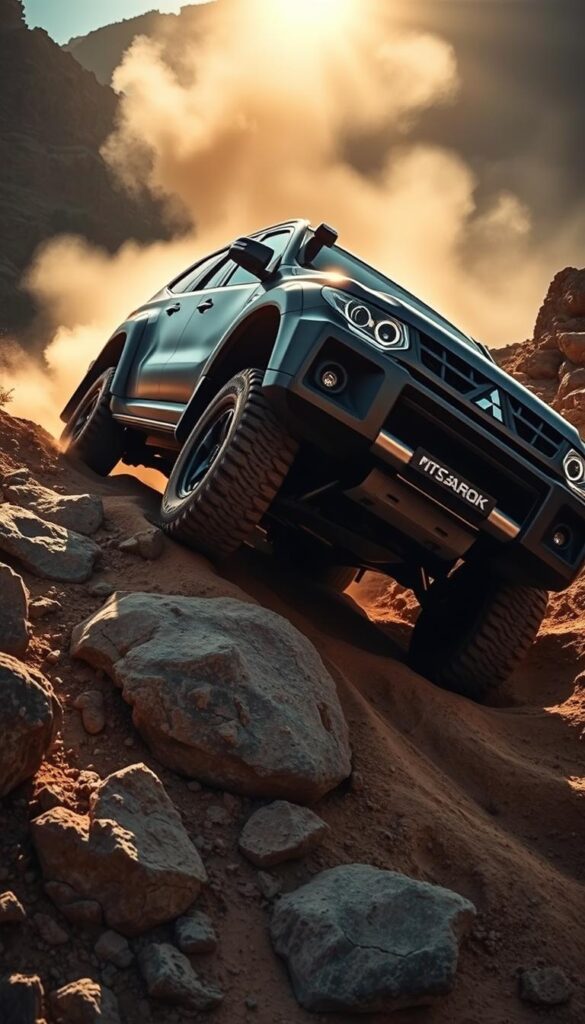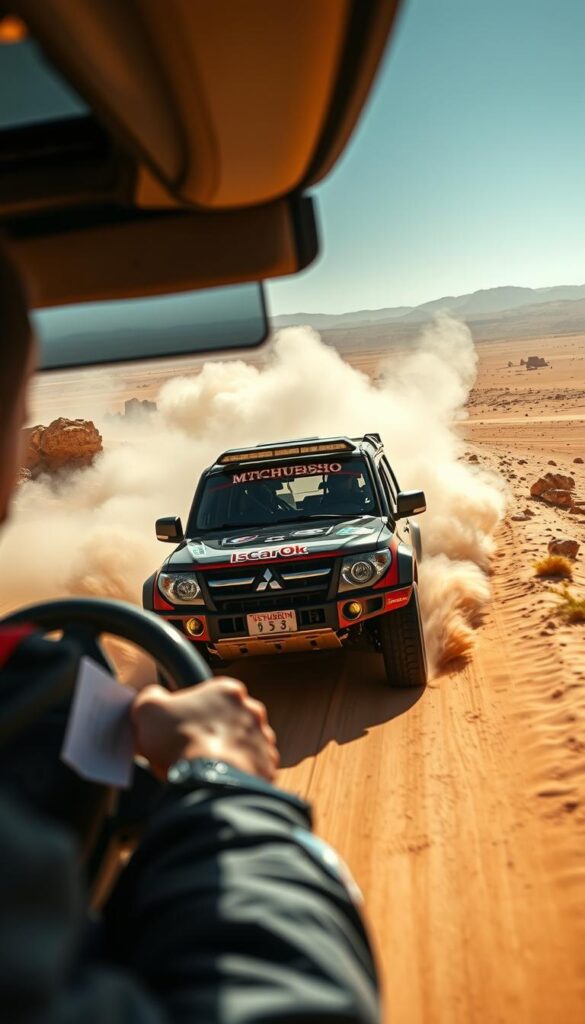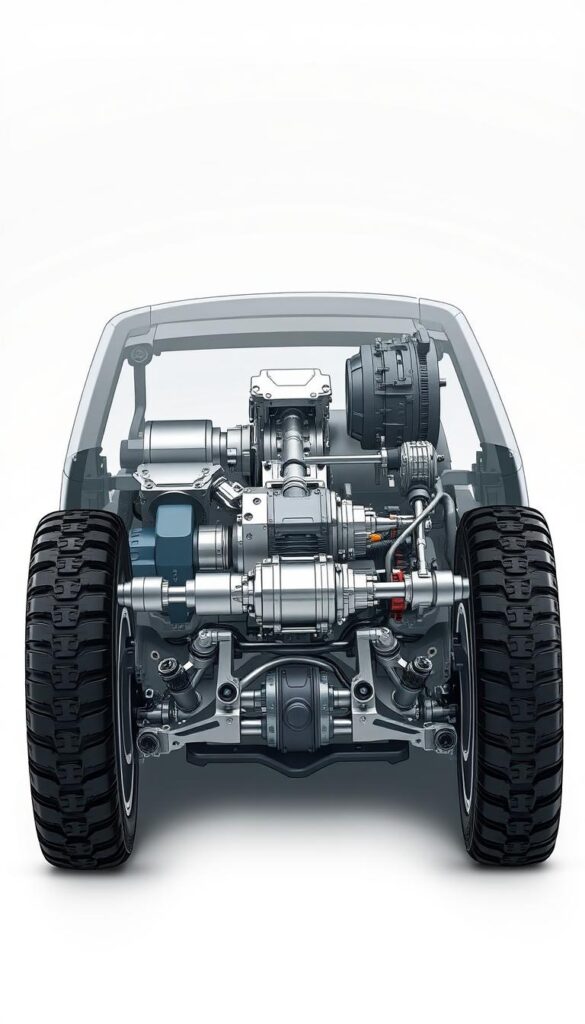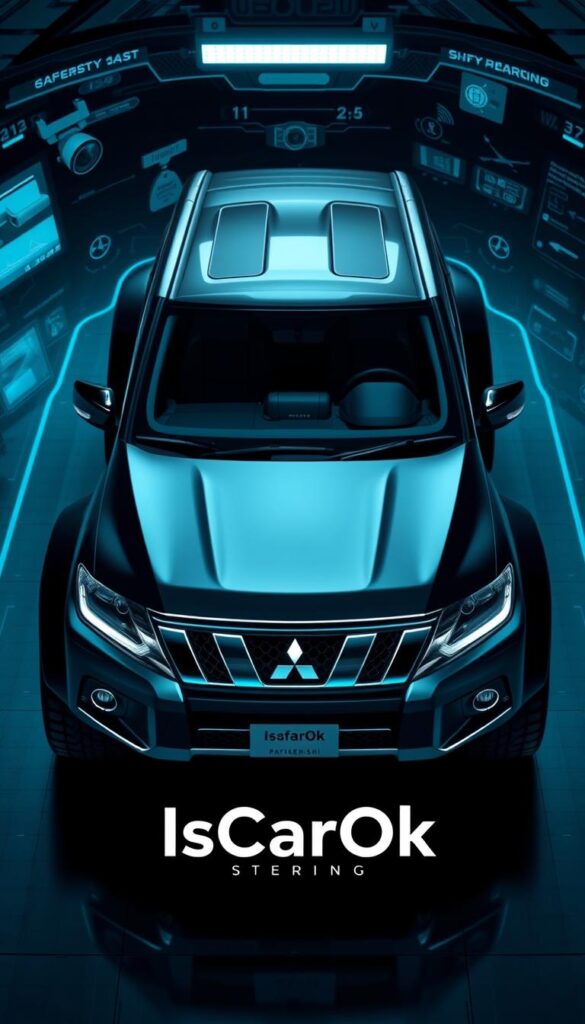Why Mitsubishi Pajero is iconic in Off-road Cars market
The Mitsubishi Pajero is a legendary off-road vehicle. It has won the hearts of many adventure lovers and off-road drivers for years. Introduced in 1981 and ending in 2021, it became more than a car. It became a symbol of toughness and trustworthiness.
The Pajero’s story is a showcase of top-notch car engineering. It was known as the Montero in the U.S. and Shogun in the U.K. This vehicle showed its strength and appeal everywhere. It was great for both desert adventures and city driving.
Its 40-year production shows its big impact on cars. Mitsubishi didn’t just make a vehicle; they created a legendary SUV legacy. This legacy still excites car fans all over the world.
Key Takeaways
- 40-year production run from 1981 to 2021
- Global recognition under multiple names
- Pioneered off-road SUV design and performance
- Renowned for exceptional reliability
- Significant impact on automotive engineering
- Successful in both consumer and competitive markets
- Represented Mitsubishi’s technological innovation
Introduction to the Legendary Pajero Legacy
The Mitsubishi Pajero marked a big change in off-road SUV history. It started long before it was officially released. You’ll see how it changed the world of rugged vehicles.
The Birth of a Legend: From Concept to Reality
Mitsubishi’s dream for the Pajero began with a bold idea. The company’s innovation came from a key government prototype in 1934 – the PX33. This early model was the start of a groundbreaking off-road SUV.
- 1934: First military prototype development
- 1973: Initial Pajero concept unveiled
- 1982: Official market launch
Understanding the Pajero Name and Global Identity
The name “Pajero” has deep cultural meaning. It comes from Spanish and means strength and quickness. Around the world, it was known by different names, showing Mitsubishi’s wide reach.
“Innovation drives progress, and the Pajero embodies that spirit of adventure.” – Mitsubishi Design Team
Market Position and Initial Impact
When Mitsubishi launched the Pajero, it changed the off-road vehicle world. The SUV had features that set it apart from others.
| Feature | Pajero Advantage |
|---|---|
| Off-Road Performance | Superior Terrain Handling |
| Design Innovation | Versatile Utility Concept |
| Market Positioning | Premium Adventure Vehicle |
Learning about the Pajero legacy starts here. It’s a tale of engineering, global vision, and innovation that changed how we travel off-road.
Why Mitsubishi Pajero is iconic in Off-road Cars market

The Mitsubishi Pajero changed the off-road car market. It brought new standards for rugged design and 4WD technology. Over 40 years, it won the hearts of many adventure lovers and professional drivers.
What made the Pajero stand out were its groundbreaking features. These features changed off-road performance:
- Innovative turbocharged diesel engine options
- Advanced front double wishbone suspension
- Precision power steering
- Comfort-focused suspension seats
The Pajero’s success is seen in its sales. Over 3.3 million units were sold worldwide. It showed that rugged design and comfort can go together. Its 4WD technology set a high standard for SUVs, making driving in tough terrains easier.
If you love adventures, the Pajero is for you. It offers top-notch off-road performance and comfort for daily driving. It can handle different landscapes, from rocky trails to desert sands, making it a true icon.
“The Pajero isn’t just a vehicle; it’s a testament to engineering excellence and adventurous spirit.”
The Pajero was more than a car. It stood for freedom, exploration, and conquering any terrain. It was perfect for weekend warriors and serious off-road fans. The Pajero set new standards for performance, changing what people expected from off-road vehicles.
The Evolution of Pajero Design and Engineering
The Mitsubishi Pajero has come a long way. It started as a tough off-road vehicle and became a global icon. Each new generation brought big improvements in off-road engineering, leading to new car innovations.
Mitsubishi always aimed to make the Pajero better. They built on what worked before, making SUVs that are both versatile and strong.
First Generation (1982-1991): Setting the Foundation
The first Pajero set important design rules for later models. It had:
- Strong body
- High ground clearance
- Powerful four-wheel-drive
- Flexible chassis
Second Generation (1991-1999): Refinement and Innovation
The second generation was a big step forward for the Pajero. Mitsubishi introduced new tech that changed the game:
- Super Select 4WD system
- Multi-Mode ABS
- Electronic shock absorbers
- Better aerodynamics
“Innovation drives progress, and the Pajero exemplified this principle in every generation.” – Automotive Design Expert
Later Generations: Modern Evolution
Later Pajero models kept improving off-road skills while adding comfort for city driving. It turned from a basic SUV to a car that’s great for both city streets and rough trails.
Every new Pajero showed Mitsubishi’s dedication to making cars that can handle different driving situations. They kept the car’s performance and reliability at the top.
Dakar Rally Dominance and Motorsport Heritage
The Mitsubishi Pajero became a legend in off-road racing with its amazing performance in the Dakar Rally. Mitsubishi’s off-road racing success showed extreme endurance and unmatched durability.

The Pajero’s motorsport legacy is incredible, with many achievements in off-road racing. From 1983 to 2007, Mitsubishi won the Dakar Rally 12 times and had 150 stage wins.
| Racing Category | Performance Highlights |
|---|---|
| Modified Production (T2) | Multiple podium finishes |
| Super-Production | Consistent top-tier performances |
| Total Overall Wins | 12 first-place victories |
The Pajero’s racing history wasn’t just about winning. It also pushed engineering to new limits. The Dakar Rally helped improve everyday driving.
- Exceptional durability tested in extreme environments
- Technological advancements derived from competitive racing
- Proven performance across challenging terrains
Understanding the Pajero’s motorsport legacy shows more than a vehicle. It shows engineering excellence and competitive spirit. The Pajero’s achievements changed what we think an off-road vehicle can do.
Revolutionary Super Select 4WD System
The Mitsubishi Pajero changed off-road technology with its Super Select 4WD system. This system was a big step forward in 4×4 technology. It gave drivers more control in tough driving situations.

Technical Innovation and Capability
Mitsubishi’s Super Select 4WD system was a major breakthrough. It has four driving modes for any terrain:
- 2H: High-range rear-wheel drive for standard road conditions
- 4H: High-range full-time four-wheel drive for mixed terrain
- 4HLc: High-range four-wheel drive with locked center differential
- 4LLc: Low-range four-wheel drive with locked center differential
Off-Road Performance Features
Your Pajero’s Super Select 4WD system gives great traction and stability. It lets you switch drive modes easily. This means you get the best performance on city streets or mountain trails.
Comparison with Competitor Systems
| Feature | Pajero SS4 | Competitor Average |
|---|---|---|
| Drive Mode Options | 4 Modes | 2-3 Modes |
| On-the-Fly Switching | Yes | Limited |
| Terrain Adaptability | Excellent | Good |
The Super Select 4WD system made the Pajero stand out from other 4×4 systems. It offered unmatched off-road ability that both fans and experts loved.
Engine Options and Performance Throughout the Years
The Mitsubishi Pajero was known for its strong engine lineup. It was a top choice for SUVs, thanks to its powerful and efficient engines. This made it a favorite among drivers.

Exploring the Pajero’s engine history is interesting. It shows how car technology has grown. The first Pajeros had engines that set a high standard for off-road vehicles.
- Early petrol engines included:
- 2.0 L 4G63 I4
- 2.6 L 4G54 I4
- 3.0 L 6G72 V6
- Diesel options featured:
- 2.3 L 4D55 turbocharged I4
- 2.5 L 4D56T intercooled diesel
The Mitsubishi Pajero was known for its diesel engines. These engines were powerful and efficient. They helped the Pajero tackle tough terrains.
| Generation | Petrol Engines | Diesel Engines |
|---|---|---|
| First (1982-1991) | 2.0L – 3.0L | 2.3L Turbo |
| Second (1991-1999) | 2.4L – 3.5L V6 | 2.5L – 2.8L Intercooled |
“The Pajero’s engine lineup represented a perfect blend of power and precision for off-road enthusiasts.” – Automotive Experts
Over time, Mitsubishi kept improving the Pajero’s performance. Later models had better powertrain options. They included advanced fuel systems and improved cooling technologies.
Interior Design and Comfort Features
The Mitsubishi Pajero is more than an off-road vehicle. It combines SUV comfort with off-road luxury, winning hearts for decades. Its interior design has changed how we see adventure vehicles.
Inside a Pajero, you find a space that’s both useful and refined. The cabin has moved from basic to a luxury level, matching top SUVs. New design updates show Mitsubishi’s focus on comfort.
Luxury Meets Utility
The Pajero’s design is all about being versatile. It has:
- Ergonomic seats with high-quality materials
- Technology to reduce noise for smoother rides
- Flexible cargo areas
- Advanced climate control systems
Evolution of Cabin Technology
Modern Pajeros come with the latest tech to improve your drive. Wireless connectivity, touch screens, and AI voice commands make driving better. They connect you to your vehicle in new ways.
The Pajero doesn’t just transport you—it elevates your entire travel experience.
Global Market Impact and Regional Variations

The Mitsubishi Pajero became a global SUV, crossing borders with its great versatility. It won hearts worldwide, showing how well it could adapt to different places. This car’s journey across the globe was a story of innovation, breaking through old limits.
Mitsubishi knew how to tailor the Pajero for each region. In North America, Spain, and Latin America, it was called the Montero. This name change helped avoid any cultural mix-ups.
- North America: Marketed as Montero
- United Kingdom: Known as Shogun
- Most global markets: Retained Pajero name
- Brazil and Jamaica: Kept original Pajero branding
Mitsubishi showed great care in naming the vehicle. In Spanish-speaking areas, they chose not to use “pajero” to avoid offense. This showed their smart understanding of cultural differences in marketing.
| Region | Vehicle Name | Key Market Characteristics |
|---|---|---|
| North America | Montero | Adventure-oriented SUV market |
| United Kingdom | Shogun | Luxury off-road segment |
| Australia | Pajero | Rugged terrain performance |
| Middle East | Pajero | Desert driving capabilities |
Every version of the Pajero was made to fit local tastes, showing its amazing flexibility. It handled everything from the Australian Outback to European cities with ease and reliability.
Special Editions and Limited Models
Mitsubishi’s Pajero lineup is more than just an SUV. It’s about creating unique, collector-worthy vehicles. This sets it apart in the off-road market. Special editions of the Pajero show the best in automotive design and performance for enthusiasts.
![]()
The Pajero Evolution is a rare gem loved by car collectors worldwide. It’s a limited edition that shows Mitsubishi’s motorsport heritage.
Evolution Model: A Collector’s Dream
The Pajero Evolution is a true collector vehicle. It has some amazing features:
- Produced exclusively for the Japanese Domestic Market
- Only 2,500 units manufactured between 1997-1999
- Based on a unique 3-door shell design
- Powered by a high-performance 3.5-liter V6 engine
Regional Special Editions
Mitsubishi also made special Pajero editions for different markets. These models had unique styling, better performance, or special design elements. They became collectibles right away.
“The Pajero Evolution represents the ultimate expression of Mitsubishi’s engineering prowess and motorsport passion.” – Automotive Enthusiast Magazine
Now, collectors and enthusiasts are looking for these rare Pajero models. Their values keep going up. The Pajero Evolution’s current market value shows how much people love these special SUVs.
Safety Features and Technological Advancements

The Mitsubishi Pajero has always led in SUV safety technology. It has changed how we think about off-road safety. Looking at the Pajero’s safety journey shows a path of innovation and tech integration.
The Pajero stands out with its safety features. The second generation brought in Multi-Mode ABS and electronic shock absorbers. These were big steps for Japanese four-wheel drives. Mitsubishi’s focus on safety grew with each new model.
- Advanced SRS airbag systems for comprehensive occupant protection
- Active Stability and Traction Control (ASTC) system
- Electronic Brakeforce Distribution (EBD)
- Reinforced Impact Safety Evolution (RISE) body structure
Later Pajero models added the latest off-road safety tech. They mixed tough performance with smart safety. The SUV had advanced driver-assistance features like:
| Safety Technology | Function |
|---|---|
| Automatic Emergency Braking | Collision prevention assistance |
| Parking Sensors | Obstacle detection |
| Rearview Cameras | Enhanced visibility and maneuvering |
Mitsubishi’s commitment to safety is clear. They aim to make off-road vehicles safer for everyone. Their work helps protect drivers and passengers in all kinds of driving situations.
Competition and Market Position

The Mitsubishi Pajero found a special place in the SUV market. It was known for being both luxurious and tough. When it came out, it faced big names like the Land Rover Range Rover and Toyota Land. It offered a great choice for those who love adventure.
The SUV market had some key changes that affected the Pajero:
- More people wanted SUVs that were easy to drive in the city.
- There was a growing need for SUVs that were good on gas.
- New crossover models were becoming more popular.
In the battle of off-road vehicles, the Pajero stood out. It faced tough competition from the Toyota Fortuner and Ford Endeavour. These rivals pushed Mitsubishi to keep improving and updating its design.
| Competitor | Key Strengths | Market Positioning |
|---|---|---|
| Toyota Land Cruiser | Extreme durability | Premium off-road segment |
| Land Rover Range Rover | Luxury design | High-end urban SUV |
| Mitsubishi Pajero | Balanced performance | Adventure-oriented SUV |
Even with the rise of crossovers, the Pajero kept its strong reputation. It was able to meet new market needs while staying true to its off-road roots. This made it stand out from many rivals.
The Final Years and Discontinuation
The Mitsubishi Pajero’s journey ended in 2021, closing a chapter in automotive history. For nearly four decades, it conquered terrains and won hearts. But, SUV market trends led to its end.

The decision to stop making the Pajero was due to several reasons. These changes reshaped the car world:
- Declining global sales volumes
- Increasing emissions regulations
- Shift towards more fuel-efficient SUV designs
- Changing consumer preferences for urban-friendly vehicles
Factors Leading to Retirement
Mitsubishi’s move was a response to tough SUV market trends. The Pajero’s old design, once loved, was no longer what people wanted. Today’s buyers want more efficient and tech-savvy cars.
| Year | Market Impact | Sales Trend |
|---|---|---|
| 2015 | Peak Performance | Strong Global Demand |
| 2021 | Discontinuation | Significant Decline |
Legacy in the Automotive Industry
Even though it’s gone, the Pajero’s legacy lives on. The Final Edition models, especially in Australia, are now rare treasures. Fans remember its off-road prowess and racing wins.
The Pajero’s impact on SUVs and Mitsubishi’s image still inspires new car designs. Its legacy will keep shaping the future of cars.
Conclusion
The Mitsubishi Pajero is more than just an SUV. It’s a symbol of automotive innovation and adventure. Its off-road status changed the SUV market, setting new standards for ruggedness and reliability worldwide.
Understanding the Pajero’s legacy is more than just knowing its history. This SUV showed that raw power and advanced technology could go hand in hand. From the 1980s to 2021, it kept pushing the limits of car design and performance.
Even as cars focus more on city driving and electric power, the Pajero’s impact is still felt. Its wins in the Dakar Rally made it a legend in off-road racing. Fans around the world still celebrate its influence on the SUV market and its ability to inspire adventure.
The Pajero’s real legacy is its ability to stand for more than just getting from point A to point B. It symbolized freedom, exploration, and the human desire to explore beyond limits. Its story is a testament to engineering greatness and the lasting appeal of a vehicle that can go anywhere.




